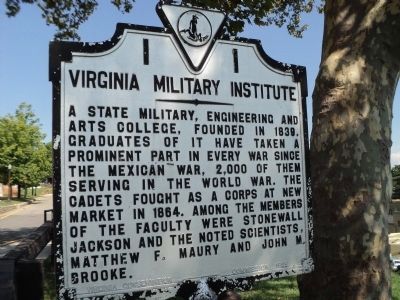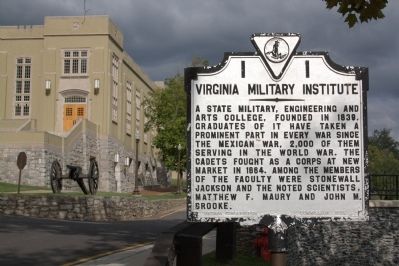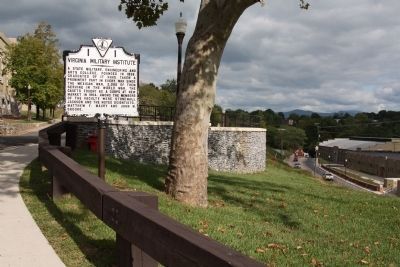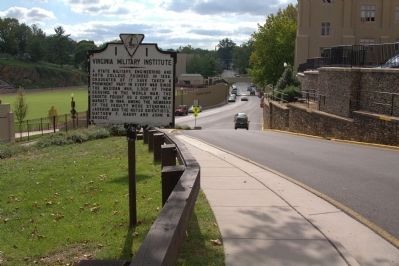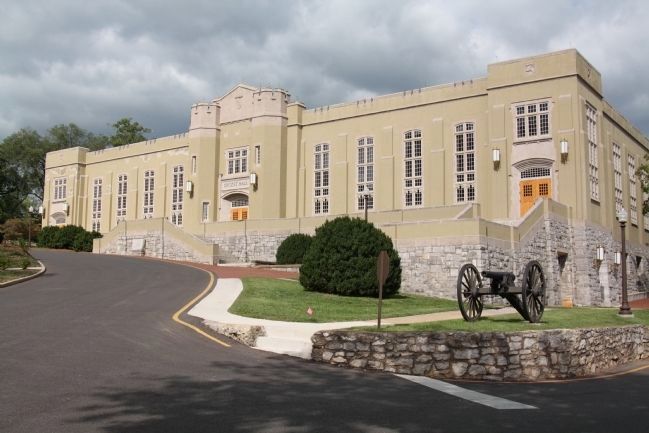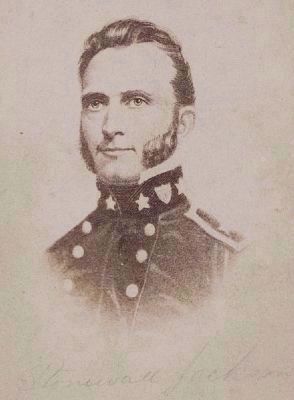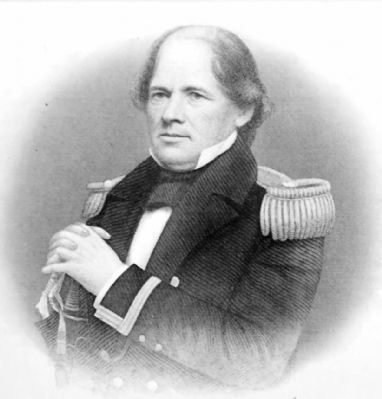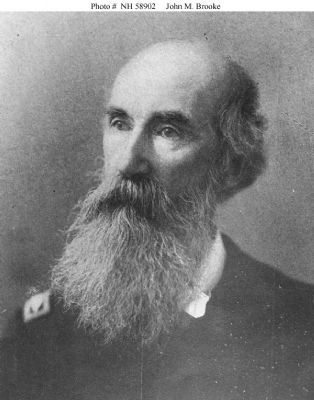Lexington, Virginia — The American South (Mid-Atlantic)
Virginia Military Institute
Erected 1939 by Virginia Conservation Commission. (Marker Number I-1.)
Topics and series. This historical marker is listed in these topic lists: Education • Science & Medicine • War, Mexican-American • War, US Civil. In addition, it is included in the Virginia Department of Historic Resources (DHR) series list. A significant historical year for this entry is 1839.
Location. Marker has been permanently removed. It was located near 37° 47.387′ N, 79° 26.043′ W. Marker was in Lexington, Virginia. Marker was on the Letcher Avenue Incline close to North Main Street (Business U.S. 11), on the right when traveling north. It is in sight of the Crozet Monument, overlooking North Main Street. Touch for map. Marker was in this post office area: Lexington VA 24450, United States of America.
We have been informed that this sign or monument is no longer there and will not be replaced. This page is an archival view of what was.
Other nearby markers. At least 8 other markers are within walking distance of this location. A different marker also named Virginia Military Institute (here, next to this marker); a different marker also named Virginia Military Institute (within shouting distance of this marker); Colonel Claudius Crozet (within shouting distance of this marker); George Washington (about 400 feet away, measured in a direct line); VMI World War II Memorial (about 400 feet away); Jackson’s Classroom (about 500 feet away); General Lemuel C. Shepherd Jr. (about 600 feet away); Virginia Military Institute Historic District (about 600 feet away). Touch for a list and map of all markers in Lexington.
Also see . . .
1. Virginia Military Institute. Wikipedia entry. “VMI produced some of America’s most significant commanders in World War II. The most important of these was George C. Marshall, the top U.S. Army general during the war. Marshall was the Army’s first five-star general and the only career military officer ever to win the Nobel Peace Prize. Winston Churchill dubbed Marshall the ‘Architect of Victory’ and ‘the greatest Roman of them all.’ The Deputy Chief of Staff of the U.S. Army during the war was also a VMI graduate as were the Second U.S. Army commander, 15th U.S. Army commander, the commander of Allied Air Forces of the Southwest Pacific and various Corps and Division commanders in the Army and Marine Corps. China’s General Sun Li-jen, known as the ‘Rommel of the East,’ was also a graduate of the VMI.” (Submitted on December 11, 2011.)
2. Stonewall Jackson. Wikipedia entry. “In the spring of 1851, Jackson accepted a newly created teaching position at the Virginia Military Institute (VMI), in Lexington, Virginia. He became Professor of Natural and Experimental Philosophy and Instructor of Artillery. Jackson’s teachings are still used at VMI today because they are timeless military essentials: discipline, mobility, assessing the enemy’s strength and intentions while attempting to conceal your own, and the efficiency of artillery combined with an infantry assault.” (Submitted on December 11, 2011.)
3. Matthew Fontain Maury. Wikipedia entry. “Maury accepted a teaching position at the Virginia Military Institute (VMI), holding the chair of physics. Maury advocated the creation of an agricultural college to complement VMI. This led to the establishment of the Virginia Agricultural and Mechanical College (Virginia Tech) in Blacksburg, Virginia in 1872. Maury declined the offer to become its first president partly because of his age.” (Submitted on December 11, 2011.)
4. John Mercer Brooke. Wikipedia entry. “Had it not been for Brooke's deep sea and core sampling device, the world would have had to wait on charting the floors of the undersea world and would not have had the undersea trans-atlantic cable for generations to come. ... in 1858 ... the Queen of the United Kingdom spoke to [U.S.] President Buchanan through the [new] transatlantic cable.” (Submitted on December 11, 2011.)
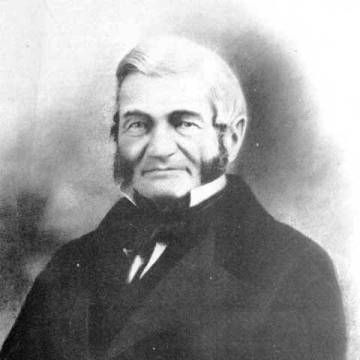
by William Garl Brown via Wikipedia Commons
6. Benoit Claudius Crozet (1789–1864)
Claudius Crozet, a VMI founder, was a French civil engineer who immigrated to the U.S. and, among many other accomplishments, built the then longest railroad tunnel in the country through the Blue Ridge Mountains without the use of dynamite.
Credits. This page was last revised on September 21, 2022. It was originally submitted on December 10, 2011, by J. J. Prats of Powell, Ohio. This page has been viewed 834 times since then and 14 times this year. Photos: 1. submitted on August 21, 2012, by Bill Coughlin of Woodland Park, New Jersey. 2, 3, 4, 5. submitted on December 10, 2011, by J. J. Prats of Powell, Ohio. 6, 7, 8, 9. submitted on December 11, 2011, by J. J. Prats of Powell, Ohio.
